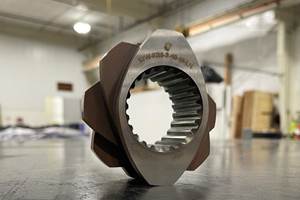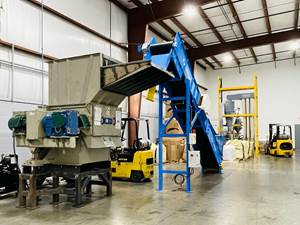Gently Does It
Unique R&D experience in urethane chemistry created a niche for New England Urethanes in North Haven, Conn., a small, highly specialized compounder serving medical-device manufacturers.
Unique R&D experience in urethane chemistry created a niche for New England Urethanes in North Haven, Conn., a small, highly specialized compounder serving medical-device manufacturers. NEU was started 10 years ago by four partners who had worked together since the 1960s and '70s in the R&D lab at Upjohn Co. near their present plant. Dow Chemical Co. bought Upjohn's polyurethane ´óĎó´«Ă˝ in 1985 and closed the North Haven lab in '89. The four chemists and engineers then decided to turn their polyurethane compounding expertise into a company of their own aimed at the specialized market for medical compounds.
The four partners and directors take turns being president. Costas Georgacopoulos is director of engineering; Curtis Smith, director of R&D; Joseph Martucci, director of manufacturing; and Robert Maler, director of finance (and current president). The company has seven other employees beside the four directors.
Quality, not quantity
Most compounders of commodity resins run high-volume,low-profit materials 24 hours a day, seven days a week," Georgacopoulos notes. "We're the opposite. Our polymers are low-volume and highly specialized for applications where quality is demanded. We run very controlled output to preserve the polymer's properties. Our jobs tend to be smaller, our margins are higher, and, in our area of expertise, we feel we make better products." An average run is 3000-4000 lb, but NEU will run lots as small as 50 lb. It sometimes also runs up to 10,000 lb in one day.
NEU also repelletizes polyurethanes to upgrade their market value. For example, it turns pellets of uneven size into uniform pellets that will run smoothly in a medical tubing line. Or it takes ground automotive and industrial scrap and reprocesses it into pellets. Since TPU is expensive ($2.90-$3.40/lb tl), reprocessing and repelletizing it can recover a lot of value for customers.
NEU offers 100 colors of its own TPU compounds, trade named Neuthane, plus a series of soft TPU compounds (down to 65 Shore A) made by alloying a proprietary blend of urethanes. NEU also creates medical masterbatches of up to 80% barium sulfate or 50% bismuth subcarbonate in polyethylene or polyurethane. However, because of the critical nature of its medical ´óĎó´«Ă˝, NEU won't touch formulations that contain potentially contaminating materials, such as fiberglass.
In addition to medical products, NEU also serves markets as diverse as sneakers, computer keyboards, and in-line skate wheels. Roughly half its ´óĎó´«Ă˝ is in its specialty of thermoplastic polyurethanes, but the firm also compounds polyolefins, ABS, nylons, and polycarbonate--about 400 different formulations in all.
Another value-added service is refining or homogenizing TPUs to give processors a narrower range of MFI, pellet size, or other properties than are available directly from resin companies. Homogenizing involves blending and drying TPUs and then very gently re-extruding them so that as little degradation as possible takes place.
Low rpm, high output
Georgacopoulos says, "A lot of people run urethanes, but not well." Running TPUs gently is NEU's secret. The homogenizing process, for example, involves a single-screw compounder--a 3.5-in., 30:1, air-cooled MX extruder from Merritt Extruder, Hamden, Conn. It has a special low-shear screw, jointly designed by NEU and Merritt.
"It pumps significantly more plastic per screw rpm, so you can run slower, but get more lb/hr," says Merritt president Sandy Guthrie. "The extruder was designed for 300 lb/hr, but with this screw it consistently exceeds 500 lb/hr," he adds. Normal screw speed for TPU extrusion would be 35-40 rpm, but this line runs at 40-65 rpm. It is used to homogenize large lots of TPU to achieve consistent properties while increasing MFI as little as possible.
Meanwhile, NEU is growing. This month, the company moves from its rental quarters to a new 17,000-sq-ft plant that it purchased nearby. The firm will also soon add a fifth, bigger compounding extruder
Related Content
How to Configure Your Twin-Screw Barrel Layout
In twin-screw compounding, most engineers recognize the benefits of being able to configure screw elements. Here’s what you need to know about sequencing barrel sections.
Read MoreUnderstanding 'Boundary Conditions' in Twin-Screw Compounding
In twin-screw compounding, the objective is generally to produce the highest quality product at the maximum strand. But sometimes there are operating parameters that prevent this objective from being realized.
Read MoreHow to Configure Your Twin-Screw Extruder: Part 3
The melting mechanism in a twin-screw extruder is quite different from that of a single screw. Design of the melting section affects how the material is melted, as well as melt temperature and quality.
Read MoreEngineering Resins Compounder Expands to Take on More Scrap
Polymer Resources responds to sustainability push by upgrading plant with grinding and shredding equipment to take on both postindustrial and postconsumer reclaim.
Read MoreRead Next
People 4.0 – How to Get Buy-In from Your Staff for Industry 4.0 Systems
Implementing a production monitoring system as the foundation of a ‘smart factory’ is about integrating people with new technology as much as it is about integrating machines and computers. Here are tips from a company that has gone through the process.
Read MoreFor PLASTICS' CEO Seaholm, NPE to Shine Light on Sustainability Successes
With advocacy, communication and sustainability as three main pillars, Seaholm leads a trade association to NPE that ‘is more active today than we have ever been.’
Read More











